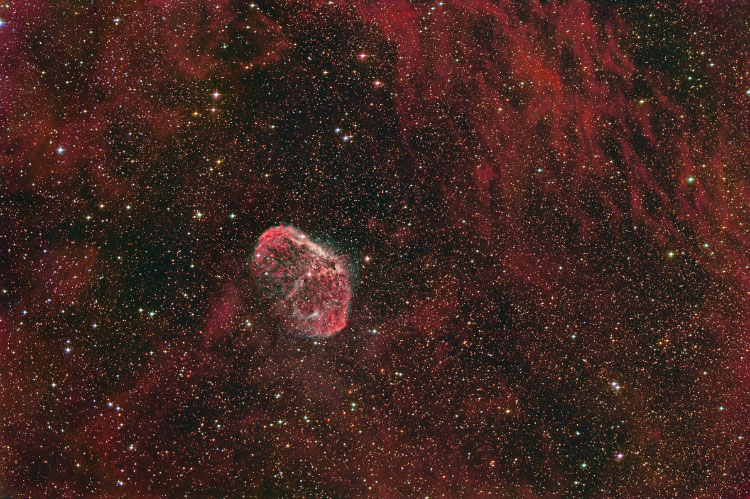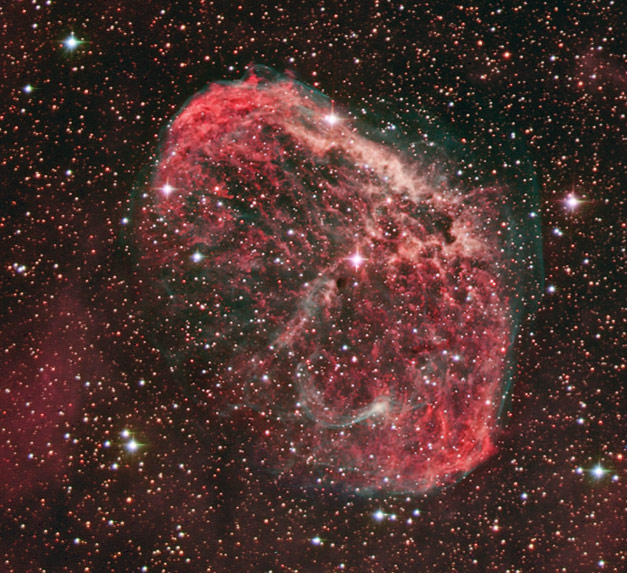|
This wide field image shows the Crescrent Nebula (NGC 6888), featuring a peculiar and unique shape within the constellation Cygnus, 4,700 light-years from Earth.
At the center of the Nebula is a very luminous Wolf-Rayet star (WR 136) that shines at magnitude 7.4, a star in the latter part of its life-cycle that is shedding off its mass in the form of a strong, stellar wind. It has shed off all its hydrogen gases leaving its helium core exposed, a dynamic that will result in a supernova explosion within the next few million years. The stellar winds stirred up the surrounding interstellar dust and gas causing ripples across the visible part of the nebula, which is now seen because the ultraviolet radiation of WR136 exciting the gases of the nebula, causing it to fluoresce. Many planetary nebulae have similar Wolf-Rayet Stars at their center.
Wolf-Rayet stars are believed to have evolved from massive (>25 solar mass) O-type stars via a period of major mass loss probably involving a very close companion star. One or more shells of expanding gas surround them. The expanding gas from the star sweeps up additional gas from the inner stellar medium.
The massive star WR 136, nearing the end of its life, is tearing apart the shell of surrounding material it blew off 250,000 years ago with its strong stellar wind. The shell of matter is a network of filaments and dense knots, all enshrouded in a thin "skin" of gas. The skin is glowing because it is being blasted by strong ultraviolet light from WR 136.
WR 136 created this web of luminous material during the late stages of its life. As a bloated, red super-giant, WR 136 gently puffed away some of its bulk, which settled around it. When the star passed from a super-giant to a Wolf-Rayet, it developed a fierce stellar wind - a stream of charged particles released from its surface - and began expelling mass at a furious rate. The star began ejecting material at a speed of 3.8 million mph (6.1 million kilometers per hour), losing matter equal to that of our Sun's every 10,000 years. Then the stellar wind collided with the material around the star and swept it up into a thin shell. That shell broke apart into the network of bright clumps seen in the image.
The stellar wind continues moving outside the shell, slamming into more material and creating a shock wave. This powerful force produces an extremely hot, glowing skin, which envelops the bright nebula. A shock wave is analogous to the sonic boom produced by a jet plane that exceeds the speed of sound; in a cosmic setting, this boom is seen rather than heard. The outer material is too thin to see in the image until the shock wave hits it. The cosmic collision and subsequent shock wave implies that a large amount of matter resides outside the visible shell. The discovery of this material may explain the discrepancy between the mass of the entire shell (four solar masses) and the amount of matter the star lost when it was a red super-giant (15 solar masses).
The nebula's short-term fate is less spectacular. As the stellar wind muscles past the clumps of material, the pressure around them drops. A decrease in pressure means that the clumps expand, leading to a steady decline in brightness and fading perhaps to invisibility. Later, the shell may be compressed and begin glowing again, this time as the powerful blast wave of the Wolf-Rayet star completely destroys itself in a powerful supernova explosion.
Find more info about NGC 6888: here.
Find a close-up on NGC6888 here.
Below you find a crop in 70% size on NGC 6888.
|

